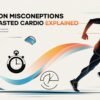Oblique Exercises for a Stronger Core | Best Workouts
Introduction
When people think of core training, the first thing that comes to mind is usually crunches or sit-ups targeting the rectus abdominis—the front section of the abs. However, the obliques, which run along the sides of the torso, play a critical role in both aesthetics and functionality.
These muscles are responsible for rotation, lateral flexion, and core stabilization, making them essential for everything from sports performance to everyday movement.
Strengthening your obliques isn’t just about sculpting a defined waistline. A powerful core enhances posture, prevents injury, and boosts overall strength. Whether you’re an athlete, fitness enthusiast, or someone looking to enhance mobility, focusing on oblique exercises can unlock new levels of stability and endurance.
Anatomy of the Obliques: Understanding Their Role
The obliques consist of two primary muscle groups:
- External Obliques: The outermost layer of the abdominal muscles, running diagonally from the lower ribs down to the pelvis. These muscles aid in trunk rotation and lateral bending.
- Internal Obliques: Located beneath the external obliques, they run in the opposite direction. They work alongside the external obliques to facilitate twisting movements and core compression.
Together, these muscles act as natural stabilizers, protecting the spine and allowing for powerful movements like throwing, twisting, and bending.
Benefits of Strong Obliques Beyond Aesthetics
While many focus on oblique training to achieve a chiseled waist, the benefits go far beyond appearance:
- Enhanced Athletic Performance: Sports like tennis, golf, and baseball rely heavily on rotational power, making strong obliques essential.
- Lower Risk of Back Pain: Strengthening the obliques provides spinal support, reducing strain on the lower back.
- Better Posture and Stability: A well-developed core prevents slouching and enhances overall balance.
- Injury Prevention: Weak obliques can lead to compensatory movements, increasing the risk of muscle imbalances and strain.
- Improved Functional Strength: Everyday activities like lifting groceries, twisting to grab something, or maintaining balance on uneven surfaces become easier.
Best Bodyweight Oblique Exercises
You don’t need equipment to build strong obliques. Here are some of the most effective bodyweight exercises:
- Side Plank with Hip Dips – Start in a side plank position and lower your hip toward the ground before lifting it back up. This engages the obliques and improves endurance.
- Bicycle Crunches – A classic core move that activates both the obliques and rectus abdominis. Twist the torso as you bring your elbow toward the opposite knee.
- Russian Twists – Sit with your feet lifted off the floor and rotate your torso side to side. Engage your core to control the movement.
- Standing Oblique Crunches – Stand tall and bring your elbow toward your knee on the same side. This movement is great for warming up the obliques.
- Side-Lying Hip Lifts – Lie on your side and lift your hip toward the ceiling, engaging your oblique muscles throughout the motion.
Oblique Exercises with Weights for Added Resistance
To build more strength and definition, incorporating weights into your oblique workout is key. Try these weighted variations:
- Dumbbell Side Bends – Hold a dumbbell in one hand and slowly bend sideways, engaging your obliques as you return to the starting position.
- Cable Woodchoppers – Using a cable machine, pull the handle diagonally across your body, mimicking a chopping motion.
- Medicine Ball Twists – Hold a medicine ball and rotate your torso from side to side in a controlled motion.
- Landmine Twists – Secure a barbell in a landmine attachment and rotate it from side to side, engaging the entire core.
- Kettlebell Windmills – Hold a kettlebell overhead and slowly lower your opposite hand toward the ground, keeping your core engaged.
Common Mistakes to Avoid in Oblique Training
Many people make common errors that can reduce effectiveness or even cause injury. Avoid these pitfalls:
- Overusing Momentum – Jerky movements reduce muscle activation. Perform exercises with control.
- Neglecting Full Range of Motion – Ensure a full contraction and stretch with each rep for maximum benefit.
- Excessive Weight Too Soon – Prioritize form over resistance to prevent strain on the lower back.
- Ignoring Opposing Muscles – Balance oblique training with overall core development to prevent muscle imbalances.
How to Integrate Oblique Workouts into Your Routine
To maximize results, incorporate oblique exercises into your routine 2-3 times per week. Here’s how:
- For Beginners: Start with bodyweight movements, performing 2-3 sets of 12-15 reps.
- For Intermediate Lifters: Add resistance and increase volume, aiming for 3-4 sets of 10-12 reps.
- For Advanced Athletes: Use weighted exercises and incorporate them into compound movements like deadlifts or rotational drills.
Combine oblique training with compound core exercises like deadlifts and squats for functional strength.
Best Supplements to Support Core Strength and Recovery
Building strong obliques requires more than just exercise—proper nutrition and supplementation can enhance muscle development and recovery. Consider these:
- Protein Powder – Supports muscle repair and growth. Whey, casein, or plant-based proteins can be beneficial.
- Creatine Monohydrate – Increases power output, helping you lift heavier weights for stronger obliques.
- BCAAs (Branched-Chain Amino Acids) – Reduces muscle fatigue and accelerates recovery.
- Fish Oil – Contains omega-3 fatty acids that reduce inflammation and support joint health.
- Magnesium – Aids muscle relaxation and prevents cramps, ensuring optimal performance.
A balanced diet combined with the right supplements can optimize your training results.
Build a Balanced and Powerful Core
Training the obliques isn’t just about aesthetics—it’s about developing a strong, functional core that enhances overall movement, performance, and longevity. By incorporating a mix of bodyweight and weighted exercises, avoiding common mistakes, and fueling your body with the right nutrients, you can build a resilient midsection that supports your fitness goals.
Stay consistent, challenge yourself, and make oblique training a staple in your routine for a more powerful, injury-resistant body.









Add comment
You must be logged in to post a comment.